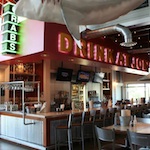Landry’s at a Glance
Location
Houston
Founded
1980
Employees
Approx. 50,000
Specialty
Restaurant and hospitality development
Annual Revenue
More than $2 billion, excluding casino operations
How has your role in the development department changed over the past 20 years?
Jeff Cantwell: When I started at the corporate office in June 1992, the development department didn’t exist. In the beginning I had to wear many hats—project manager, project superintendent, and project designer—as we built one restaurant at a time, doing two or three a year. As we ramped up our growth, we began building half a dozen restaurants a year, then a dozen, and at one point we were building 50 restaurants a year.
This growth made it necessary for Landry’s to hire project superintendents, so I no longer needed to physically be on location every day. An additional project manager was brought in to help write purchase orders, track spending, and keep scheduling. As we continued to grow and hire more people, my position became more supervisory and administrative.
What does your job look like on a daily basis?
JC: My day involves reviewing project budgets, reviewing project plans, and meeting with project managers, project architects, and consultants. Time is spent approving bills, signing purchase orders, and meeting with Landry’s owner, [Tilman J.] Fertitta, to review plans and discuss progress on projects. Additionally, I travel frequently, visiting facilities that are in development or [inspecting] existing locations from a maintenance perspective.
What challenges come with maintaining so many brands at once?
JC: Nothing is standardized, not only with the various brands. When you have 40 stores within a brand, each has different finishes, floor plans, and construction requirements. This requires us to dial into a level of detail that you wouldn’t necessarily have to if you had a standardized plan that fits every property. The biggest challenge is staying on top of that, but it’s exciting and invigorating at the same time.
Jeff Cantwell: Career Timeline
1980: Begins working as a busboy and dishwasher at the age of 15 at the original Landry’s Seafood House in Katy, TX
1980–1991: Works in various restaurant-operations and construction positions while in high school and college
1992: Graduates cum laude from Texas State University with a bachelors degree in design; starts as project design manager at Landry’s
1994: Receives a promotion to director of design and construction the same year that Landry’s acquires Joe’s Crab Shack and Bayport Restaurant Group and begins rapid expansion
1996: Becomes vice president of design and construction
1997: Celebrates opening of the 100th Landry’s restaurant
2001: Receives promotion to vice president of development, one year after Landry’s goes international with the purchase of the Rainforest Cafe brand
2002: Becomes senior vice president of development
2005: Begins an aggressive renovation plan of the Golden Nugget properties, totaling $160 million over the next three years
2011: Commences 12-month renovation plan to convert Atlantic City’s Trump Marina Casino and Hotel into a Golden Nugget property
2012: Completes construction and redevelopment of the Galveston Island Historic Pleasure Pier amusement park
How does your team work with contractors and subcontractors in the different regions?
JC: Doing this for as long as we have, Landry’s has a lot of long-standing relationships. We have general contractors in Texas; Las Vegas; Florida; Washington, DC; and the West Coast markets, and most of them have the ability to do projects around the country. Most of these general contractors will walk across coals to get things done for us, and we appreciate that; there are loyalties on both sides of the relationship. We also have subcontractors that travel all over the country for us, regardless of the market we are in.
The contractors and subcontractors are integral to our success. They’ve allowed us to go into markets and do things quicker than others could because we didn’t have to establish a new relationship and train them on our expectations. We strive to value-engineer each project, and these relationships help us to reduce our costs because [the contractors] know how we operate.
How much of your time is currently devoted to renovations?
JC: In addition to maintaining and updating our existing restaurants, in 2011 and 2012 we purchased McCormick & Schmick’s and Morton’s the Steakhouse. Between those two restaurant companies, there [are] over 160 locations, most of which have not been updated in years, so we’re implementing a rather extensive renovation plan for those concepts.
We’ve done prototypical stores here in Houston and are now rolling them out across the country. We have a three-year plan to renovate all these properties with our teams of project managers and project designers—in addition to working on new capital expenditure projects like our Golden Nugget properties in Biloxi and Atlantic City.
Talk about some of the specifics in the Golden Nugget renovations.
JC: We purchased the Trump Marina Hotel and Casino in May 2011 and embarked on a 10-month, $150 million renovation project before unveiling Golden Nugget Atlantic City. The renovation included the remodel of 740 rooms and suites, the conversion of some restaurants to our existing brands—including Chart House and Vic & Anthony’s—the construction of a new spa, and the addition of a retail corridor. The lobby and casino were also renovated; we added several new bars and party pits as well as two restaurants on the casino floor: Grotto and Lillie’s. The exterior was expanded, redesigned, and refinished.
The Golden Nugget Biloxi renovation will include an overhaul of all the guest rooms and suites, a casino expansion of 50,000 square feet that includes new bars and high-limit areas, a renovation of all the existing gaming, the addition of Morton’s the Steakhouse and Bubba Gump Shrimp Company, new retail stores, a new exterior façade, and a new resort swimming pool area with a swim-up bar and outside table games.

How did the firm jump from restaurant development into the hospitality sector?
JC: Landry’s has been developing outside the restaurant sector since 1995, with the addition of the San Luis Resort. The Hilton Hotel at the San Luis Resort was originally built by Fertitta in the ’80s and was sold to George Mitchell, who developed the San Luis Resort and built the San Luis Hotel and Condominiums. Mitchell decided in the mid-’90s to sell [back] the entire resort complex. In 1997, we decided to redevelop the Kemah Boardwalk, which not only included restaurants but [also] a boutique hotel, retail stores, an amusement park, and other boardwalk activities.
Are there differences between hospitality development and restaurant development?
JC: Hospitality and entertainment development involves a lot of the same disciplines but includes another layer of details because now you are providing services to your guest for a period that is longer than a dining experience. You are providing places to play and to rest. For that, you need to understand your guest a little better and design to their expectation versus them coming to you because they know what to expect from your restaurant.

Does Landry’s have plans to develop any new brands?
JC: Our growth plans are typically opportunistic and based on growing our various businesses through slow, calculated, organic growth or acquisition opportunities. Because of our experience and reputation, we see a lot of opportunities, and we have a stable core group of brands, [so] we can look at the location and decide what brand makes the most sense for the market. It makes us a one-stop shop for developers and people looking for restaurant operators. ABQ



